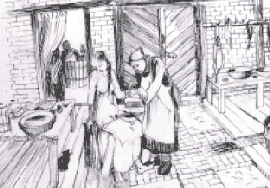Meet the Middle Ages
BackMedical healthcare

People of the Middle Ages fell ill and had accidents just like we do. In the towns, where people lived close to one another, diseases spread quickly. The plague and other diseases could also spread easily, because the towns were not very clean.
One advantage of living in a town was that if you fell ill, there were people nearby who could help you. In the convents and hospices in town, there were monks and nuns who knew a lot about how to cure different kinds of diseases. In the convent gardens, they grew plants and herbs used for medical treatment. Many monks and nuns became very good at taking care of sick or injured people. They knew how to put broken legs and arms in place, how to stitch up wounds and how to prepare the right medicine. They also said prayers for the patient, which could be of some help.
As well as the monks and nuns, there was often a wise woman in town. She could make a small cut and open a vein of the sick person. This was done to let out old and sick blood, and was believed to both cure and prevent diseases. To stay in good health, it was recommended that people should let their blood four times a year.
We know of some physicians from the Middle Ages. They were appointed by kings and noblemen. King Magnus Eriksson had his own physician, Lars Johansson. He prepared a medicine against the plague, called teriak. It was made from around 70 different ingredients, among them snake-meat and ground cranium. We do not know if it did any good.
If you would like to read more about disease, go to "Society. Life and Death" and "Country Life. Workdays and Holidays".